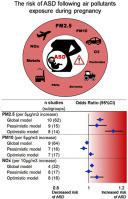Environmental Pollution ( IF 7.6 ) Pub Date : 2021-03-02 , DOI: 10.1016/j.envpol.2021.116856 Frédéric Dutheil , Aurélie Comptour , Roxane Morlon , Martial Mermillod , Bruno Pereira , Julien S. Baker , Morteza Charkhabi , Maëlys Clinchamps , Nicolas Bourdel

|
Despite the widely-known effects of air pollution, pollutants exposure surrounding pregnancy and the risk for autism spectrum disorder (ASD) in newborns remains controversial. The purpose of our study was to carry out a systematic review and meta-analyses of the risk of ASD in newborns following air pollution exposure during the perinatal period (preconception to second year of life). The PubMed, Cochrane Library, Embase and ScienceDirect databases were searched for articles, published up to July 2020, with the keywords “air pollution” and “autism”. Three models were used for each meta-analysis: a global model based on all risks listed in included articles, a pessimistic model based on less favorable data only, and an optimistic model based on the most favorable data only. 28 studies corresponding to a total of 758 997 newborns were included (47190 ASD and 703980 controls). Maternal exposure to all pollutants was associated with an increased risk of ASD in newborns by 3.9% using the global model and by 12.3% using the optimistic model, while the pessimistic model found no change. Each increase of 5 μg/m3 in particulate matter <2.5 μm (PM2.5) was associated with an increased risk of ASD in newborns, regardless of the model used (global +7%, pessimistic +5%, optimistic +15%). This risk increased during preconception (global +17%), during pregnancy (global +5%, and optimistic +16%), and during the postnatal period (global +11% and optimistic +16%). Evidence levels were poor for other pollutants (PM10, NOx, O3, metals, solvents, styrene, PAHs, pesticides). PM2.5 was associated with a greater risk than PM10 (coefficient 0.20, 95CI −0.02 to 0.42), NOx (0.29, 0.08 to 0.50) or solvents (0.24, 0.04 to 0.44). All models revealed that exposure to pollutants, notably PM2.5 during pregnancy, was associated with an increased risk of ASD in newborns. Pregnancy and postnatal periods seem to be the most at-risk periods.
中文翻译:

自闭症谱系障碍和空气污染:系统评价和荟萃分析
尽管空气污染已广为人知,但怀孕期间的污染物暴露以及新生儿自闭症谱系障碍(ASD)的风险仍然存在争议。我们研究的目的是对围产期(出生前至第二年)暴露于空气污染后的新生儿进行ASD风险的系统评价和荟萃分析。搜索PubMed,Cochrane图书馆,Embase和ScienceDirect数据库,查找到2020年7月发布的关键词为“空气污染”和“自闭症”的文章。每种荟萃分析都使用了三种模型:基于所包含文章中列出的所有风险的全局模型,仅基于不利数据的悲观模型以及仅基于最有利数据的乐观模型。包括28项研究,共758 997名新生儿(47190名ASD和703980名对照)。孕产妇暴露于所有污染物与使用全球模型的新生儿ASD风险增加3.9%,使用乐观模型的母亲增加12.3%,而悲观模型未发现变化。每次增加5μg/ m不管使用哪种模型,<2.5μm(PM2.5)的颗粒物中有3例与新生儿ASD风险增加相关(全球+ 7%,悲观+ 5%,乐观+ 15%)。在孕前(全球+ 17%),怀孕期间(全球+ 5%和乐观+ 16%)和产后阶段(全球+ 11%和乐观+ 16%),这种风险增加。其他污染物(PM10,NOx,O3,金属,溶剂,苯乙烯,PAHs,农药)的证据水平很差。与PM10(系数0.20,95CI -0.02至0.42),NOx(0.29,0.08至0.50)或溶剂(0.24,0.04至0.44)相比,PM2.5的风险更高。所有模型均表明,暴露于污染物(尤其是怀孕期间的PM2.5)与新生儿ASD风险增加相关。怀孕和产后时期似乎是最危险的时期。









































 京公网安备 11010802027423号
京公网安备 11010802027423号